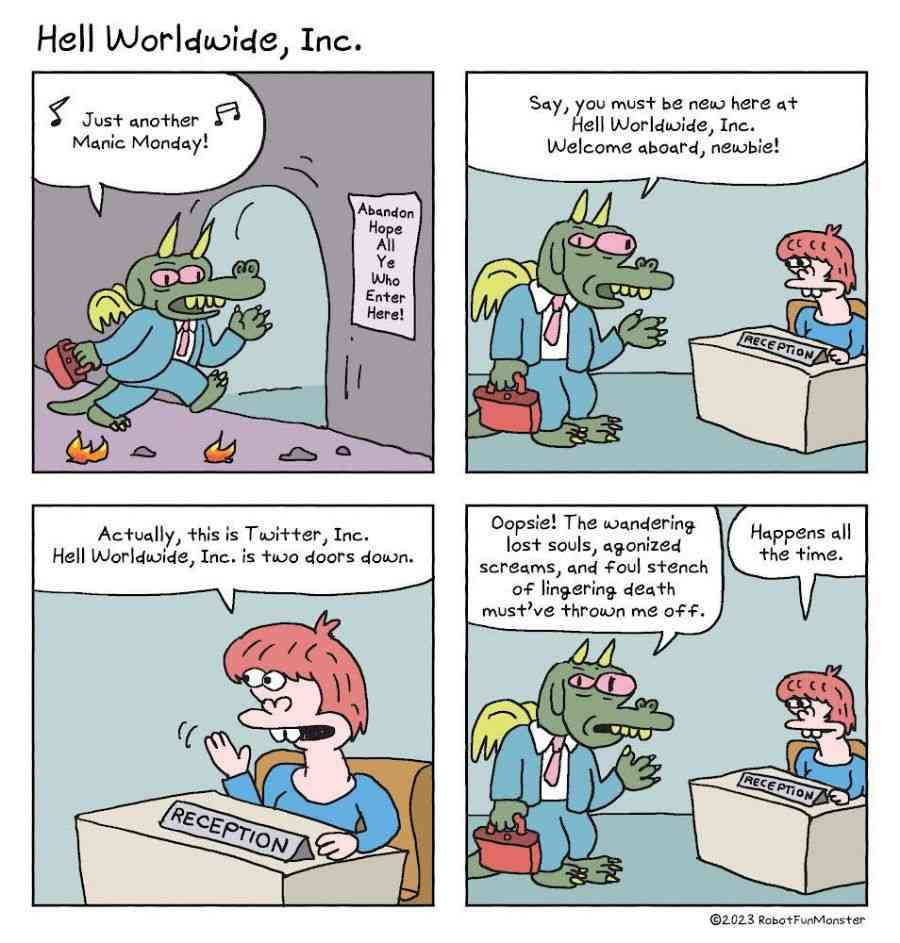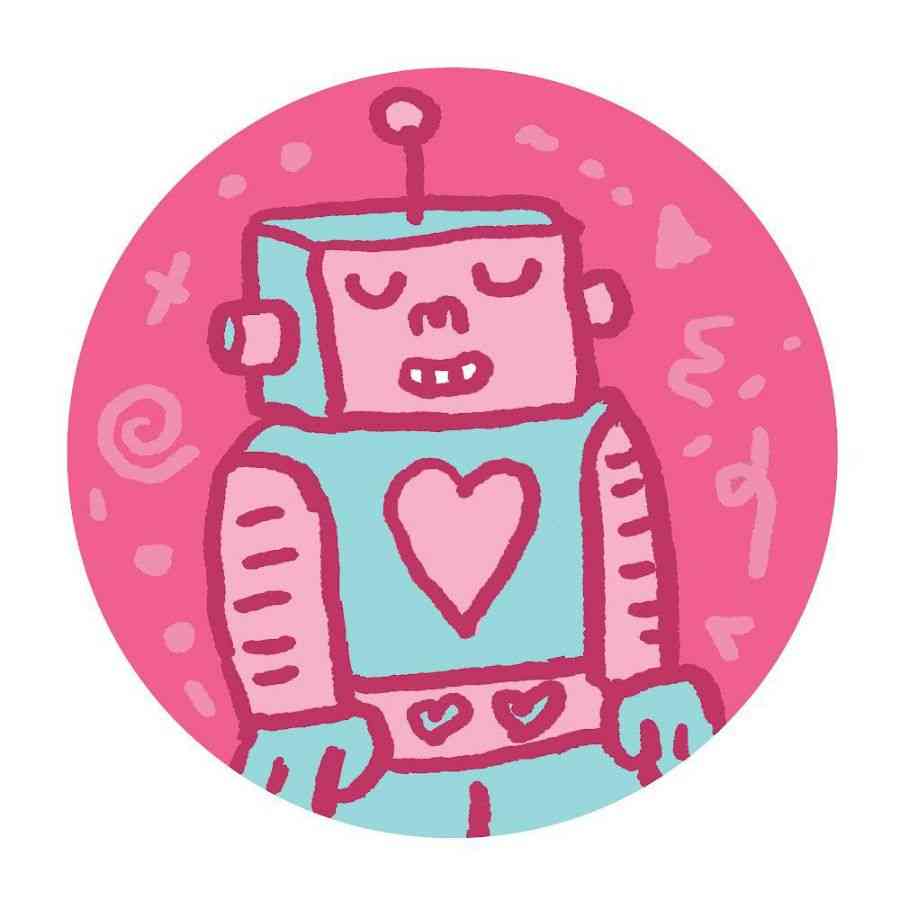Robot Fun Monster interview by Anthony Andujar Jr 3/18/23
Interviewee: Robot Fun Monster
Interviewer: Anthony Andujar Jr
Hello, Robot Fun Monster! Thank you for taking the time to partake in this interview about your work. As usual, I’m always fascinated by comic creators of different genres, and your work caught my attention due to its bubbly art that is fun on the surface, but underneath, contains some depth as all good cartoonists tend to create.
Q1. What started your path into art, comic books and comic strips? What were the first comics you read, and what resonated or inspired you to create your own?
RFM: It all started the day my father gave me a drawing lesson, when I was seven. I think Peanuts, and Pogo comic strips inspired me, at first, as well as vintage Bob Clampett, Jay Ward and Warner Brothers animation. The first comic books I remember reading were things like, Archie, Archie’s Madhouse and Mad Magazine. And I was a big fan of Dr. Seuss books. Comic strips were definitely my main interest, though, in terms of what I wanted to create myself. Also, I do remember spending hours and hours just creating and drawing characters (mostly non-human).
Q2. Who are your influences in comics and other media? How do they inform the kind of work that you create?
RFM: I’ve definitely gone through stages, in terms of professional influences. When I was in college, and more comic strip-focused, I was heavily influenced by strips like Doonesbury (I had a paperback of just his college stuff and it was really funny), Peanuts, Pogo, and early Krazy Kat and Popeye. I actually learned how to write funny comic strips, in a structured way, by studying their work one summer. I also got into 1970’s and 80’s undergrounds and National Lampoon cartoonists (Ed Subitsky, Claire Bretecher, Rick Meyerowitz, Ron Hauge, Mimi Pond, etc.) for a while, and, yes, Matt Groening (Life in Hell). More recently, I think Gary Baseman, James Kochalka, Lloyd Dangle, Mark Marek, Jen Sorenson, Gemma Correll, Joey Allison, Steven Appleby, Gary Panter, and Ruben Bolling had an impact. And, I think my writing may have been subtly influenced by NYer cartoonist Roz Chast, and possibly cartoonist/authors Allie Brosh and Ruby Elliot, as well. I’ll also give props to George Booth, William Steig, Bill Woodman and Jack Ziegler of the NYer for influencing me, in some way. Now, of course, I’m trying hard to ignore all past influences and find my own style and voice.
Q3. You’re known for drawing cartoons of anthropomorphic characters. Was that always the kind of material that you drew? Was it inspired by the idea of fables? Why these characters and what do you attempt to express through them?

RFM: I’m not sure why, but it was always more fun for me to create anthropomorphic characters. I don’t think it was fable-related. And I realize it’s harder for many readers to relate to anthros, but I was strangely bored with drawing humans. I’ve always struggled with writing autobiographical/diary comics, too (but I love reading them). Even when it came to good old-fashioned short story writing, I never wrote about myself.
I’m struggling right now with which direction to take my comic writing. If you’ve seen my entire IG page, I started out with political and/or social satire stuff, but I don’t consider myself an editorial cartoonist. And I must’ve posted a dozen or so different comic strip worlds, each with unique characters, since 2020, but I’ve yet to land on one definitive comic strip. The one advantage to having multiple comic worlds to choose from is if I have a random idea I can usually fit it into at least one of them. I’m also struggling to incorporate lgbtq+ themes into my work because I’m so used to being funny and non-auto-biographical, and I’m not sure yet how to revise my writing style or even to what extent I should. I’m not sure who’s noticed, but in the past year or so, I’ve posted a lot more stand-alone art/drawings and a lot less written comics/cartoons while I figure things out.
Q4. What is your process like when illustrating a comic strip? Do you make a script? Do you just draw thumbnails? What’s your process?
RFM: So for written comic strips, I tend to hand write them (in sketchbooks) with accompanying thumbnails, on an actual piece of paper. The handwriting is practically indecipherable and the thumbnail drawings aren’t much better. It’s a primitive first draft. If I have something (an idea) that makes me laugh or that I think could potentially make me laugh, then I start working it out on the computer. Pro dialog tip: it usually helps to know what the last frame is going to say, roughly, and work backward from there.
On the computer, things are more streamlined. I have three- and four-frame blank strips set up as templates in Photoshop. And I have my own handwriting as a digital typeface. (Though, sometimes I’ll hand draw the letters for effect) I tend to add the words first, and then create drawings to fit, once I think the writing works. I rarely scan anything in, and most of the time I don’t even do a rough sketch on the computer. But I do erase/redraw lines, or copy, rotate or scale parts of a drawing. I have learned, too, that sometimes the drawing can make a big difference in determining whether something is ultimately funny or not. There are a lot of last minute changes to the writing, too, usually involving cutting down the number of words, after the drawing is complete. There have been plenty of times I wished I could edit comics that I’ve already posted, too, just to change a word, or a sentence.
The drawings themselves don’t take nearly as long as the writing, on average. I’ll just use the basic pencil tool or a brush tool that I like in Photoshop, with my Cintiq Pro 13 drawing display and pen. The coloring can be pretty routine, if I’ve used the characters before because I save a color palette for each comic strip world I create in Photoshop.
Q5. What are your favorite challenges when illustrating your strips?

RFM: When I’m creating a new comic strip that needs a whole new set of characters, that’s got to be my favorite challenge. Creating new characters is a challenge. but at the same time it’s probably one of my greatest strengths.
Q6. What are some of the difficult challenges that occur when illustrating comic strips?
RFM: Er, drawing straight lines? (Buildings, furniture, and machinery are not my favorite things to draw).
Q7. Color has a great impact on your art. The complimentary colors that you infuse with your comic strips deliver a fun energy to them. What comes to mind when you apply color to your work? What’s your thought process?
RFM: I do get a lot of positive comments on my colors (used in my stand alone drawings). It’s an intuitive process for me. Whatever feels right, sort of. Of course, my coloring used to be awful when I was limited to just doing things on paper and I only had one shot at it, until I switched to digital coloring. The fact that everything is in Photoshop and on layers, make it pretty easy to change colors as often as I want, until I find something I like. That doesn’t stop me from changing my mind about colors, constantly, though. And half the time, I’m never quite satisfied.
It’s a lot easier to color the comic strips, too. They usually have an established color palette for all the characters and backgrounds so it’s basically paint-by-numbers. It’s the stand-alone art/drawings that take a while to color. Actually, the coloring can take twice as long as the line drawing on those because of all the color tweaking I do.
Q8. Have there been other kinds of genre strips that you’ve drawn before? What keeps the process engaging and fun for you as a creative?
RFM: Hmmm… I’ve done editorial cartoons, gag cartoons, illustrations, and humor-based comic strips. The comic strips I’ve created so far skirt the edges of multiple genres. I mean, they’re all humor-based, but I’ve done political, sci-fi, funny animal, detective/spy, supernatural/occult, fantasy/sword and sorcery. I’ve thought about a longish-form comic, but haven’t tried one yet. Maybe someday. As long as I have the energy and I’m in a decent mood, it can be fun and engaging.
Q9. Are there any genres of comic strips or comics that you’ve considered trying your hand in?
RFM: Not specifically a genre, but animation is something I’d love to try, or at least be a part of. I don’t need to be the actual animator. I think I could develop characters and stories or scripts, though. And, I don’t know, maybe something more kids-oriented, like in the book field. You never know though, I may opt to go all in on lowbrow pop surrealism art one day.
Q10. What projects do you have in the pipeline that readers should keep an eye out for? Where can readers find your work?
RFM: I know I want to do a comic that’s more lgbtq+-centric. Also, I have some sci-fi, and fantasy ones that I hope to get back to. Maybe something political, too (I think I’m too upset about things right now to be funny, politically). And then there’s always “Bad Rudolph,” and “Heartless J. Moneymaker, Professional Billionaire”. Such jerks, but so much fun to write for. Right now, my Instagram page hosts all my work: https://www.instagram.com/robotfunmonster/

